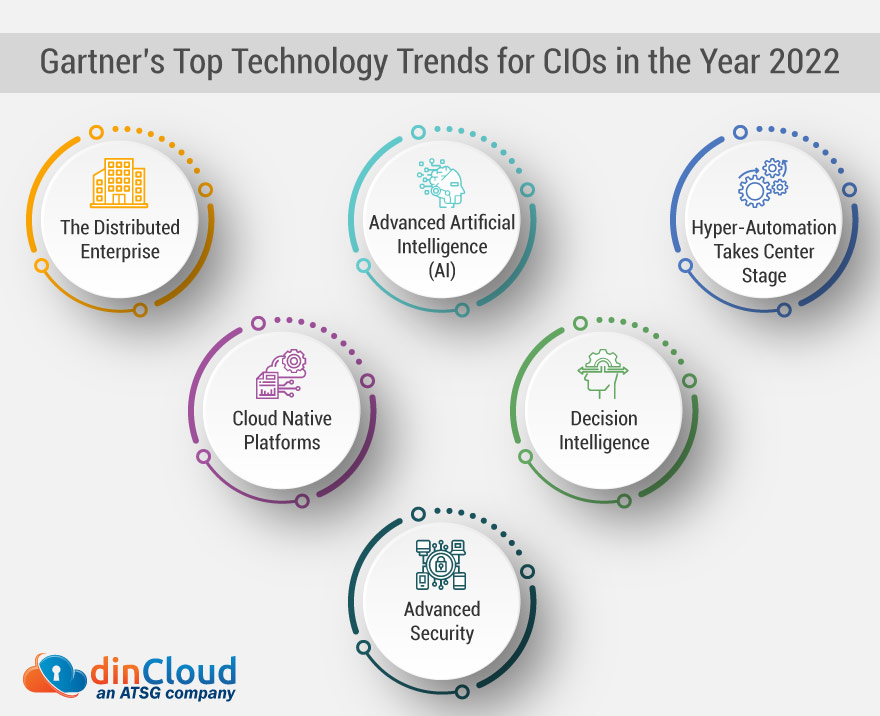Digital technologies are assuming a pivotal role in modernizing and streamlining enterprise operations. According to research company Gartner, the Cloud, Artificial Intelligence (AI) and Hybrid Work patterns will be among the dominant tech trends for the year 2022.
In 2022, Chief Information Officers (CIOs) will be extensively leveraging digital technologies in a bid to accomplish two major goals. The first priority is to better equip their enterprise for the current, and any future disruptions as well.

Related: Cloud and Edge Based Virtual Power Plants (VPPs) – The Future
The second most important priority for CIOs moving into 2022 includes tapping new business opportunities by quickly and securely deploying digital technologies. This in turn will help enterprises regain their foothold in the market after a devastating pandemic.
In this post, we will discuss some of Gartner’s top technology trends that will dominate the year 2022, and will help CIOs better align their IT infrastructures and processes with present day needs and challenges.
The Distributed Enterprise
In most cases, the physical workplace will not be coming back, at least for the first half of the year 2022. As a result, CIOs will have to come to terms with the concept of a distributed enterprise to get things done in a timely and seamless manner.
This by no means implies that physically dispersed individuals and teams won’t leverage organizational resources. Instead, remote employees will be relying more than ever on the right digital technologies to undertake their day to day tasks in a seamless manner.
Related: Database as a Service (DBaaS) – The Next Iteration of the Cloud
Advanced Artificial Intelligence (AI)
This is an emerging technology, but CIOs will need to leverage it to create the much needed competitive edge in the market. Advanced AI will be playing a key role in two critical areas, one of which is managing IT resources smartly and efficiently, especially cloud resources.
The second area where advanced AI will have a major role to play is cyber security. Given the present day cyber threats, CIOs shall be leveraging AI based tools to identify gaps and vulnerabilities in the realm of security, in addition to real time protection.
Related: Bulk of Enterprises to Pivot towards “Cloud First” by 2025 – Gartner
Hyper-Automation Takes Center Stage
There is a consensus view among the top tiers of management that if CIOs can automate the repetitive processes within an enterprise, the valuable time and human resources that will be relieved can add real value to the enterprise through innovation.
So, Gartner expects a wave of hyperautomation in the current year, which will mainly focus on trivial organizational processes that can be automated with little coding and development. Technologies like AI may also play an assistive role in process automation.
Related: How are Cloud Solutions a Key Enabler for Business Mobility?
Cloud Native Platforms
In the year 2022, enterprises will be moving away from a “lift and shift” approach for cloud migrations. Instead, most CIOs will invest time, planning and resources in developing cloud native applications and solutions, from the ground-up.
If that may not be possible due to time or resource constraints, the second preference of CIOs would be to adopt “off the shelf” enterprise solutions, but ones that have been purpose built for the Cloud, not retro-fitted to it in an arbitrary manner.
Decision Intelligence
This is an extension of the automation we have cited above within select enterprise processes. In a bid to eliminate whimsical and arbitrary decision making process, CIOs will aim to leverage decision intelligence to make organizational decisions well structured.
This approach will bring transparency, visibility and accountability within the decision making echelons of the enterprise. This in turn will not only optimize organizational decision making processes, but also improve the overall quality of business decisions.
Related: Session Based Desktops v/s Virtual Desktops – A Helpful Guide
Advanced Security
With more workloads and processes making their way to the Cloud, cyber security will have to catch up. While the Cloud Service Providers (CSP) will primarily focus on the security of their core infrastructures, enterprises will have to manage most of their in-house security.
Enterprise cyber security is gradually but surely moving away from human intervention to automated and AI based tools, which provide real-time and contextual security against existing as well as emerging threats or vulnerabilities.
Going forward, enterprises will have to elevate their security postures to also incorporate threat response mechanisms that do not wait for human intervention, rather act as soon as there is an emerging cyber threat that poses a risk to enterprise data or processes.
Related: A Peek into Cloud Computing Trends for 2022
Conclusion
Gartner’s top technology trends for the year 2022 indicate a lot of ground that still needs to be covered by Chief Information Officers (CIOs) and Chief Information Security Officers (CISOs). Digital and cloud technologies will be playing a central role in such initiatives.
Contact dinCloud for best in class cloud solutions that are secure, reliable and very cost efficient.


